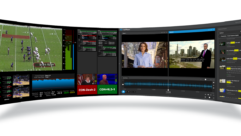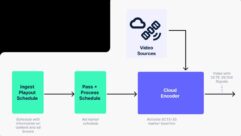An elegant solution
Nov 1, 1999 12:00 PM,
Christopher Buttner and Michael Schwartz
Using CobraNet and fiber optic-based audio networks to transport multiple,noise-free audio channels and overcome complex routing challenges at theSydney Opera House.
Built on Bennelong Point in Sydney Harbor, one of the most beautiful sitesin the world, the Sydney Opera House is probably the most famous andarchitecturally unusual building in Australia, if not the world. Itssignature design, resembling the windblown sails of a giant ship, is alandmark easily recognized as one of the premier performing arts centers inthe world. Since it opened in 1973, the Opera House is among the world’sbusiest. Some 3,000 events attract as many as two million patrons annually,not including the hundreds of thousands of tourists who visit the complex.The 4.5 acre (1.8 hectare) complex houses nearly 1,000 rooms and fiveperforming venues for a seemingly endless variety of arts programs – fromtraditional theatre, opera, dance and music programs to contemporary artexhibitions, programs and films.
The recent completion of the SOH’s newest stage – The Studio, a 400-seatmulti-purpose venue – also marked the completion of a new paging andcommunications system, designed and installed by The PA People, a prominentSydney-based systems integration firm, and Creative Audio, its sisterorganization in Brisbane, Australia. Solving complex routing anddistribution challenges is not new for The PA People. The company recentlyinstalled a CobraNet system in the Sydney Olympic Stadium in preparationfor next year’s Olympic Games. The SOH system is a centralized DSP-baseddigital audio network built around QSC RAVE (Routing Audio Via Ethernet)and Peavey MediaMatrix hardware, and it is a prime example of howfiber-based audio networks can ensure that multiple audio channels aretransported free from noise, even in the most complicated routingsituations.
Inside the house
Five performance venues (listed in descending order of size), the mainConcert Hall, Opera Theater, Drama Theater, Playhouse and The Studio, rangein seating capacities of 2,700 to 400. The complex also houses an elaboratemaze of rehearsal studios, eateries, lounges, dressing rooms,administrative offices and numerous mechanical equipment rooms.
Routing audio throughout this complex, multi-purpose facility posed severalchallenges to The PA People. The system had to be versatile enough tohandle multiple audio inputs and control sources simultaneously, largeenough to distribute audio to 65 remote paging zones, and flexible enoughto satisfy the individual production communications requirements of eachvenue and peripheral support areas. Also, as with all paging systems usedpartly for emergency purposes, it had to be virtually failsafe.
The Opera House is located 820 feet (250 m) from the main shipping lines ofSydney Harbor – an extremely high electrical noise environment – making itsusceptible to interference. Plus, there was a significant amount ofelectrical noise radiation within the building, said Chris Dodds, managingdirector of The PA People. Fiber optic cabling, which is free from groundloops, totally immune to EMI and capable of redundant operation, proved tobe the ideal choice for the job.
“To meet the design requirements that were proposed,” Dodds said, “weclearly needed a fiber optic-based signal distribution solution. We havefound CobraNet and the QSC RAVE/Peavey MediaMatrix combination to be auseful solution to a number of difficult audio signal transport,distribution and signal processing/routing problems. QSC Audio was thefirst to have a CobraNet solution available with its RAVE system, and wehave been more than happy with the product and their support throughoutthis project.”
Key components of the paging system, all designed and built by CreativeAudio, are controlled on a 10Base-T data distribution network, separatefrom the CobraNet audio network. Paging control components include sixcustom-engineered consoles for stage and production managers, multiplepaging stations that control pages in various zones, a Digital MessageStore and forward system (DMS121), which stores pre-recorded pagingannouncements; loudspeaker control panels and remote-controlled micpreamps. Other system devices include auditorium mics, program sends fromthe venue mixing consoles, local mixers, ambient noise level sensing (ANLS)mics and monitoring mics for the foyer and dock areas.
At the heart of the audio system is the 100Base-T fiber optic networkestablished using QSC RAVE digital signal transport units and Fast Ethernethubs. The entire system is fully redundant to ensure that the signal pathremains intact if the primary network fails. A separate 10Base-T datadistribution network, which is not connected to the audio fiber network, isused for system control purposes.
Audio network: CobraNet configuration
The audio network is basically arranged in a star configuration. At thecenter of the star is the central control room, which houses two redundantMediaMatrix systems. MediaMatrix handles all audio signal routing for thepaging system as well as such audio processing functions as equalization,compression and dynamics. The endpoints of the star topology are eightoutlying audio racks located throughout the complex that house variouscomponents of the fiber and data distribution networks. A fiber optic-basedRAVE digital audio network routes the audio between the locations.
The RAVE88s in the central control room each handle up to eight AES/EBUdigital inputs and outputs and interface with the MediaMatrix via anAES/EBU daughter card interface, ensuring that the audio remains in thedigital realm throughout the network. Outlying audio racks contain aRAVE188, each handling as many as eight analog inputs and eight analogoutputs. Paging audio signals, whether prerecorded messages, liveannouncements or such miscellaneous sounds as bells or chimes, are routedthrough the RAVE188 inputs to the MediaMatrix, where they are processed androuted back through the network to the paging amps and loudspeakers.
RAVE uses CobraNet technology to route audio over standard Ethernethardware and cabling. CobraNet, a digital audio networking technologydeveloped by Peak Audio, Boulder, CO, has been licensed to a growing numberof pro audio manufacturers. It uses standard Fast Ethernet 100Base-Tcomputer networking equipment to distribute up to 64 channels ofuncompressed 20 bit digital audio over hub-based networks. CobraNet cantransmit up to 64 channels through a single, inexpensive CAT-5 networkcable or fiber optic cable. Because CobraNet uses off-the-shelf FastEthernet 100Base-T hubs and minimal cabling, hardware and labor costsinvolved in an installation are significantly reduced.
Two servers independently monitor the operating status of each MediaMatrixmachine using the built-in “runtime diagnostics” feature. If a fault isdetected in the primary machine, the server switches over to the secondarymachine. This ensures that in the event the primary system fails, it willmake a seamless transition to the secondary unit without an interruption topaging system operations. MediaMatrix runs MWARE, a software controlprogram, and Peavey Architectural Acoustics Serial Handling Adapter(PASHA). This allows each MediaMatrix machine to be controlled through itstwo RS-232 ports from a rack-mounted PC, referred to as “the MediaMatrixserver,” and a special MediaMatrix Monitor panel (MMM3) made by CreativeAudio. The MMM3 is an embedded PC-based device that communicates with theMediaMatrix machines via an RS-232 connection. It accepts a single balancedaudio input, which is the monitor audio for its front panel loudspeaker.The MMM3 uses the PASHA control protoc!ol to instruct the MediaMatrix machine to deliver the desired audio source to its monitor input. Two MMM3sare used, one for each MediaMatrix machine.
Data distribution network Paging sources and control
Paging system control data is transmitted on a separate 10Base-T datanetwork, which is not connected to the CobraNet audio network. (CobraNetrequires a dedicated network using 100Base-T Fast Ethernet.) Each processorhooked to the data network is equipped with two 10Base-T compatible networkinterface cards (NICs). These run in parallel and are used to satisfysystem redundancy requirements. A QNX OS, a real-time 32 bit UNIX-styleoperating system customized by The PA People and Creative Audiospecifically for this installation, runs on each of the networkedprocessors and will automatically load share between the two NICs. If onefails, it will immediately and transparently divert all traffic to theoperational device. Embedded processors are built into each of the stagemanagers’ desks and their associated node racks as well as the data serverslocated in the production manager’s office and the central control room.These are all connected to the network using a star-confi!guration LAN.
Five consoles serve as the primary source of paging announcements. Theconsoles, referred to as “stage manager desks,” are located in eachperformance venue and accessed by individual stage managers. Each consoleis a custom work surface to control not only the paging systems, but alsotimers, cue lights, video monitor source selection, intercom and LEDsignage. A sixth operating position is located in the Opera House’sproduction office.
Five paging stations throughout the complex are the secondary source ofpaging announcements. These stations service areas not included in thezones controlled by the consoles. Loudspeaker levels, monitoring mic levelsand other network devices can be adjusted from more than 125 control panelsat various locations.
Each stage manager desk interfaces with the paging system via the embeddedserver located in the node rack for each venue. The servers, which run QNXsoftware, are connected to the data network via two interface cards. Thisprovides a redundant, fail-safe data path in the event of a failure. Stagemanagers can route paging requests to the MediaMatrix server, upload anddownload desk configuration information from the production office, andindicate engaged paging zone groups.
The production office console uses a PC-server setup with a standardkeyboard monitor mouse interface using QNX. It is accessible via TCP/IPlink with servers connected to it. The console also allows for remoteconfiguration of each stage manager console and each paging station, and itprovides a mechanism for indicating and logging system faults. The fileserver itself is connected to the system via the 10Base- T data network.The QNX network and file manager supervises the transfers over thisconnection to and from the other data nodes. The file server also holds theconfiguration files for the stage manager consoles and paging stations.These can be accessed by other nodes on the network according to theread/write privileges assigned to them.
Monitoring control
Each stage manager desk has two audio inputs (a monitor input and theatrecommunications input) and three outputs (for paging, public address andtheatre communications). Monitor inputs originate from five sources -auditoriums, foyer areas, prerecorded announcements and sounds and pagingstations.
In each of the five auditoriums, a stereo mic pair is provided tofacilitate live recording and to program sound distribution throughout theOpera House. The two mics are sent to the local control room in each venue,where each channel is amplified using a Creative Audio MP405remote-controlled preamp. Adjustments to gain, signal phase,phantom power,20-B input pad and output mute are equally effected on both channels. Thestereo audio pair emanating from the MP405 appears as two XLR connectors inthe control room rack of each venue. A mono sum is generated and fed to thedigital audio network via the local RAVE188 and on to the MediaMatrix.
Auditoriums are also equipped with a Creative Audio C141 Concert Comintercom unit and a 24-channel cue light controller. The cue lightcontroller is controlled from the stage manager’s desk node server and iscontrolled via one of its parallel input/output ports. The node server alsocontrols the mic preamp and C141 ConcertCom via separate RS485 links.
Background audio levels for the auditoriums and foyer areas can also beadjusted using any of the 125 Creative Audio Speaker Volume Control (SVC1)panels located throughout the facility. The paging audio is constrained toa predetermined level regardless of the background audio level. The SVC1svary levels by switching taps on the associated paging loudspeaker. Thecontrollers are instructed to switch to a preset tap whenever a pagingannouncement is issued to the associated loudspeaker zone. The volumecontrols are addressable devices, which are set via DIP switches on thedevice itself.
Special mics are used to pick up and monitor ambient noise levels in thefoyer areas of the Opera House. These Ambient Noise Level Sensing (ANLS)mics are preamplified at the source as part of the Creative Audio RMM1remote monitoring mic unit(s). The RMM1 produces one compressed and oneuncompressed line level output for the monitoring and ANLS mics,respectively. These outputs are then fed directly to the audio network viathe nearest RAVE188.
The MediaMatrix server also oversees the operation of the DMS121 digitalmessage store system. The server can detect paging activity in variouszones, as well as store and play announcements at designated times. Theserver also gathers status information on power supply levels and amplifiermonitoring and broadcasts any discovered faults to the production office.
Paging stations set up throughout the Opera House are the secondary sourceof audio for the paging system. The stations provide access to the systemfrom areas not serviced by a stage manager desk. From any paging station,the user can select from four groups of destination paging zones. Stationsare linked to the closest venue server data network via RS-485 connections.Paging requests and engaged zone group information are transferred via theRS-485 link. A single audio output carrying paging audio is provided ateach station.
Other network-controlled devices
A host of other A-V devices are linked to the digital data distributionnetwork. Control panels in various foyers throughout the Opera Housecomplex allow an operator to alter the audio source for local paging zones,vary background audio levels and enable a local mixer. Control informationis sent via an RS-485 link to the nearest data network node. The localmixers provide four audio inputs to a single audio output. The output isconnected to the nearest RAVE188 input device where it is then carried tothe MediaMatrix for switching.
Two Adaptive Micro Systems 32 128 pixel, tri-color LED displays areinstalled in an artists’ lounge known as the Green Room. The displaysprovide visual indication of the paging sources for the Green Room zone.Control of these displays are via dual RS-485 links, one per display. TheRS-485 interface adapters are housed in the nearby production office fileserver.
Remote loudspeaker level controllers located in every room are alsoserviced by the paging system. These controllers are attached in parallelacross the balanced RS-485 feed and accessed individually using apredefined address. Multiple networks, and hence multiple RS485 adapters,are used to cover the entire complex.
Local mixers are provided at locations throughout the SOH. The mixersprovide four audio inputs to a single audio output. The output is connectedto the nearest RAVE188 where it is then carried to the MediaMatrix systemfor switching. The RMM1 Remote Monitor Microphone is used to permit bothremote audible monitoring of sound in a given area and/or for use as thesense transducer for ambient noise level control equipment. Two outputs areprovided from the unit. These are connected separately to the nearestRAVE188 CobraNet input device for distribution over the digital audionetwork.
Conclusion
The SOH paging and communications system demonstrates how a fiber-basednetwork using standard, affordable computer networking devices caneffectively transmit multiple channels of audio throughout a complex venue.Long distances no longer have to require an expensive, inflexible coppercabling infrastructure. RAVE-based networks solve those problems by routingdozens of channels of digital audio – free from EMI and ground loops – overdistances of up to two kilometers. As illustrated in the Sydney OperaHouse, digital audio networks are proving to be a viable system solutionfor today’s systems contractors.
“The Sydney Opera House paging system is a landmark project for our companyin terms of both the profile of the building and the technology involved inthe solution,”said Dodds. “We are very pleased with the results, and welook forward to applying our expertise to other venues with similar complexrequirements, both in Australia and overseas.”










